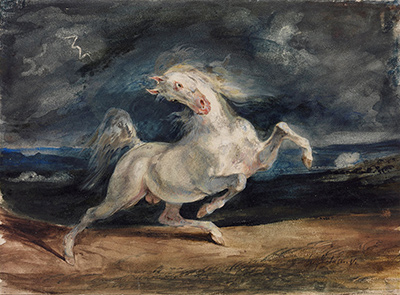The painting was completed in 1825 and can be found in Museum of Fine Arts, Budapest.
In this watercolour painting, a white horse is frightened by the lightning, rears up in a storm. The bold use of colour and detailed brushwork captures the reaction of the animal with care, conveying panic and terror.
The landscape and the stormy sky provide an ominous scene for the alarmed, rearing horse. The lighting illuminates a stormy, blue sky framing the startled animal in centre of the picture.
The fearful look and red eyes draw the viewer into the turbulent surroundings of the panic-stricken horse. Other examples of his paintings that portray horses include Massacre at Chios (1824), The Combat of the Giaour and Hassan (1826), and Collision of Moorish Horsemen (1844).
Eugene Delacroix was famed for his use of expressive brushstrokes and his groundbreaking understanding of the optical effects of color. He is believed to have created over 9,000 artworks during his life and was influenced by artists such as Peter Paul Rubens (1577–1640) and Théodore Géricault (1791–1824).
For Delacroix, the use of vivid color was more important than outline of an object in a painting, as was so typical in the neoclassical perfectionism. His sensitive use of colour is very well demonstrated in his watercolour painting Horse Frightened by Lightning.
Ferdinand Victor Eugène Delacroix miraculously survived five brushes with death. He was born on April 26, 1798, in Charenton-Saint-Maurice, Île-de-France, France. He died on August 13, 1863, at age 65.
The painting Massacre at Chios quickly established him as the leading painters of the Romantic style and one of Frances greatest painters and lithographers of all time, and he is featured on a French banknote.
His painting of Jacob wrestling with the Angel on the eastern wall of St. Sulpice has been called the finest mural painting of its time. The sometimes controversial painter deeply inspired a many generations of famous artists including Renoir, Manet, Seurat and Van Gogh.
